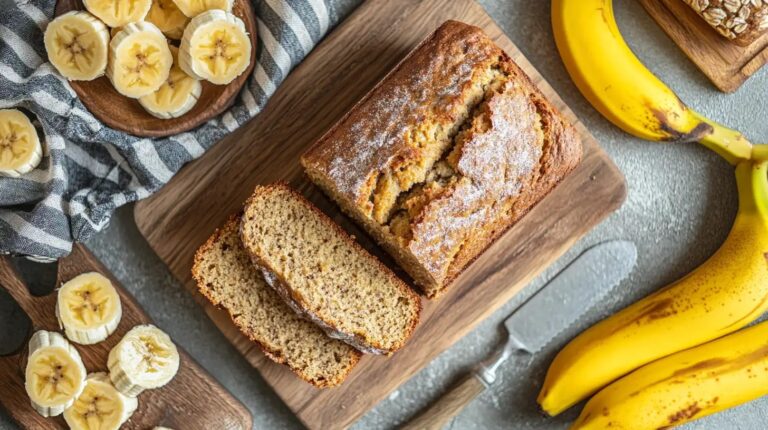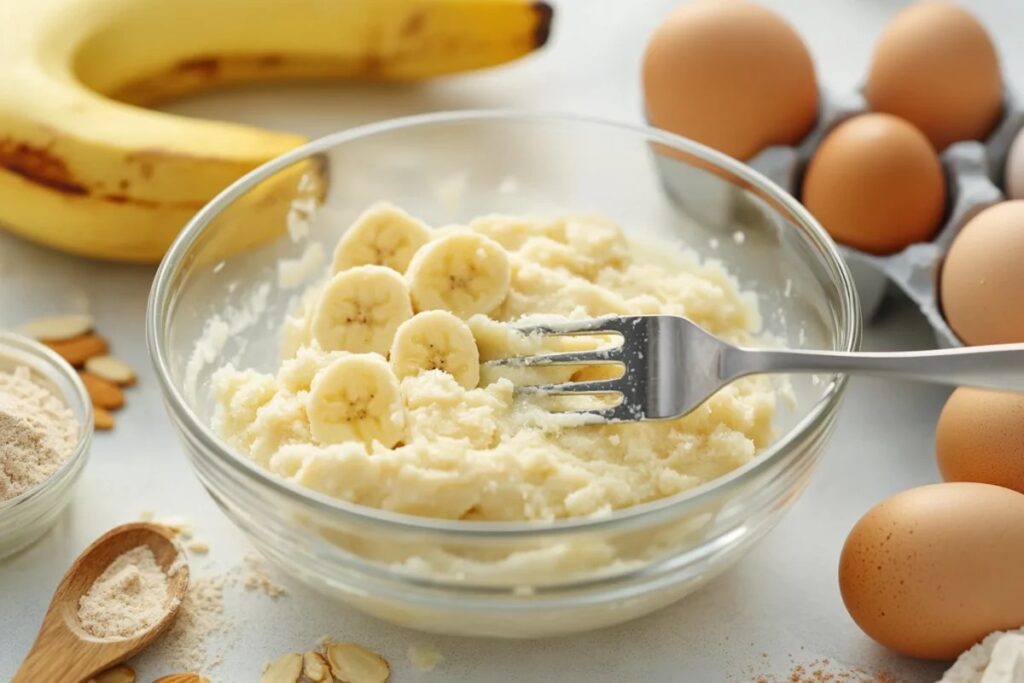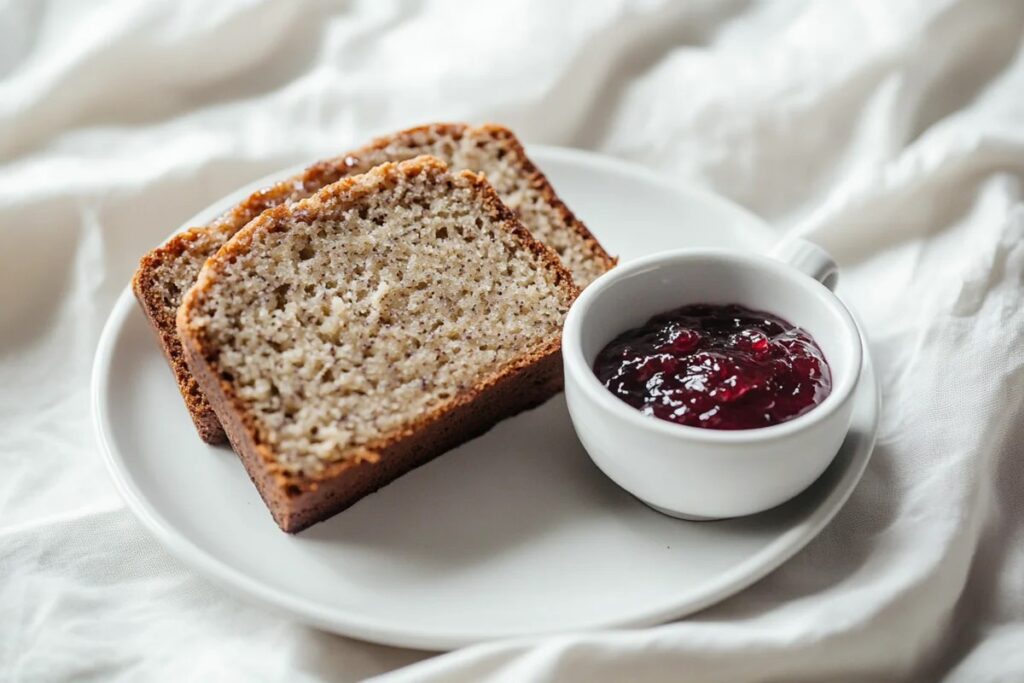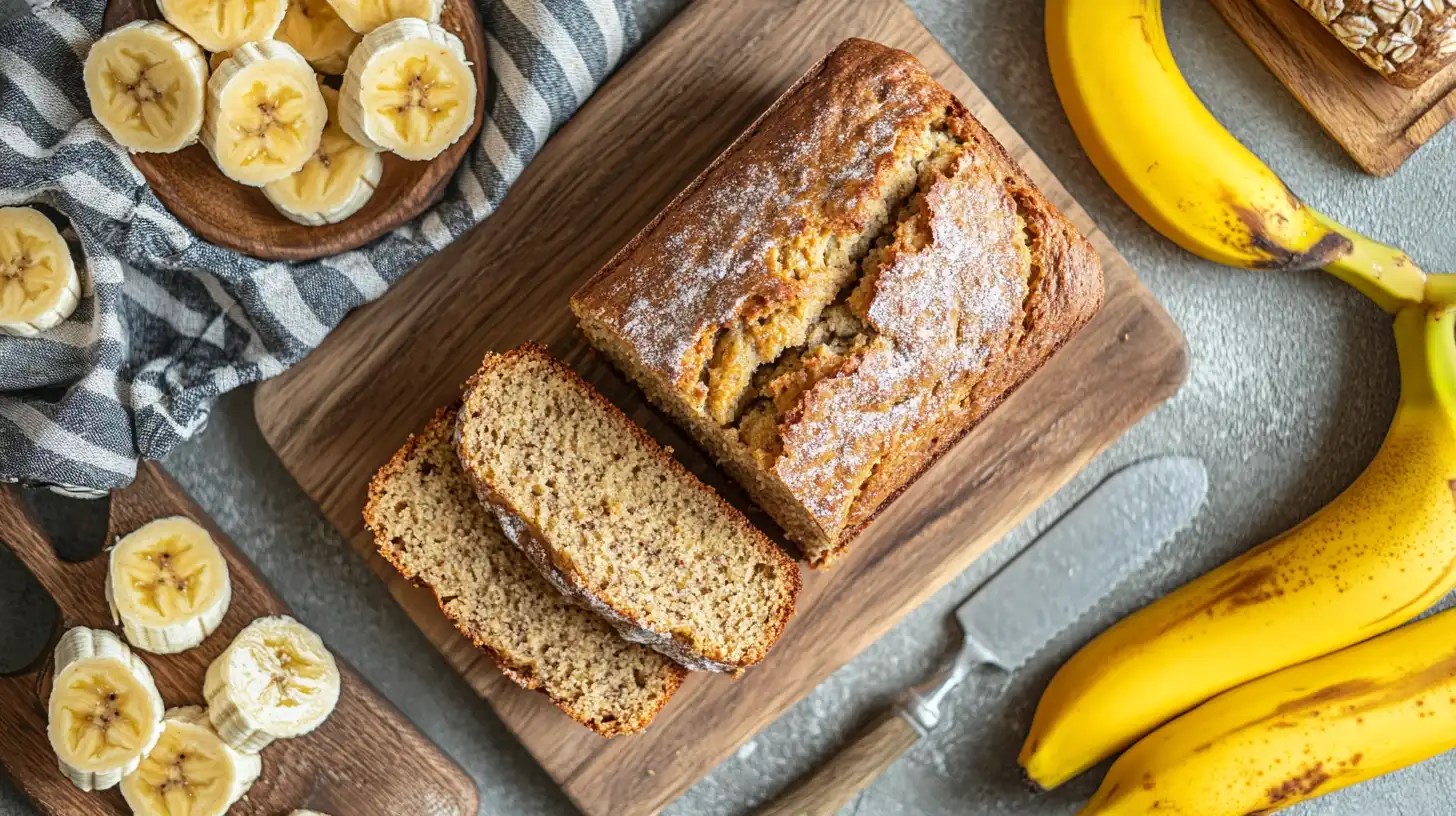Introduction
Diabetic banana bread offers a gentle sweetness and moist texture. Basically, it’s a delightful twist on a classic favorite that suits individuals watching their sugar intake. Indeed, this bread replaces high-glycemic ingredients with better-for-you options. Consequently, you can enjoy a comforting slice without feeling guilty. Moreover, the unique mix of whole grains, ripe bananas, and sugar substitutes creates a balanced treat. Altogether, it’s a perfect option for anyone who wants a healthier baked good.
This article explains how to bake a tender, flavorful loaf that aligns with diabetic needs. Furthermore, it includes guidance on choosing ingredients, controlling sweetness, and adding extra flavor without excess sugar. Equally important, you’ll learn about proper storage, portion sizes, and pairings that keep blood sugar stable. Finally, by the end, you’ll understand how to create a loaf that’s good for the body and comforting for the soul.
Print
Diabetic Banana Bread: A Healthy Twist on a Classic Recipe
Diabetic banana bread offers a moist, lightly sweet loaf using low-glycemic ingredients and natural banana flavor—a perfect snack for managing blood sugar.
- Total Time: 65 minutes
- Yield: 10 slices 1x
Ingredients
3 ripe bananas, mashed
2 large eggs
1/4 cup plain Greek yogurt
1/3 cup erythritol or monk fruit sweetener
1 tsp vanilla extract
1 cup whole wheat flour
1/2 cup almond flour
1 tsp baking soda
1/2 tsp baking powder
1/2 tsp cinnamon
1/4 tsp nutmeg
1/4 tsp salt
Optional: 1/4 cup chopped walnuts or sugar-free chocolate chips
Instructions
1. Preheat oven to 350°F (175°C) and line a loaf pan with parchment paper.
2. Mash bananas in a bowl until smooth.
3. Whisk in eggs, yogurt, sweetener, and vanilla.
4. In a separate bowl, mix flours, baking soda, baking powder, salt, and spices.
5. Fold dry ingredients into wet mixture gently.
6. Add optional mix-ins if desired.
7. Pour into prepared loaf pan and spread evenly.
8. Bake for 50–60 minutes or until toothpick comes out clean.
9. Cool in pan for 10 minutes, then transfer to wire rack.
10. Slice and serve once completely cooled.
Notes
Store in an airtight container for up to 3 days at room temperature or refrigerate for 1 week.
For longer storage, freeze slices and thaw as needed.
Pair with Greek yogurt or nut butter for a balanced snack.
- Prep Time: 10 minutes
- Cook Time: 55 minutes
- Category: Bread
- Method: Baking
- Cuisine: American
Nutrition
- Serving Size: 1 slice
- Calories: 130
- Sugar: 2g
- Sodium: 170mg
- Fat: 5g
- Saturated Fat: 1g
- Unsaturated Fat: 3g
- Trans Fat: 0g
- Carbohydrates: 16g
- Fiber: 3g
- Protein: 4g
- Cholesterol: 30mg
Why Diabetic Banana Bread Is Perfect for a Healthier Lifestyle
Diabetic banana bread stands out because it uses gentle sugars from ripe bananas rather than refined white sugar. Consequently, it can help maintain more stable blood sugar levels. Generally, standard banana bread contains lots of sugar and processed flour, which can spike glucose. Conversely, this version relies on wholesome swaps. Equally, it’s not only for those with diabetes. Indeed, anyone who wants a more balanced sweet treat will love it.
Meanwhile, this bread can fit into many dietary patterns. For example, you can slice it thinly for a quick snack or serve it with a protein-packed side. Basically, when combined with wholesome ingredients, diabetic banana bread can help you meet nutritional goals. Thus, it isn’t just about taste—it’s about smarter ingredients and improved well-being.
Understanding Diabetes and Low-Sugar Baking
Diabetes often requires careful management of carbohydrate intake. Therefore, baking with reduced sugar can make a positive difference. Initially, people might fear losing flavor. However, that’s not the case. In fact, by using alternative sweeteners and nutrient-dense flours, you can still enjoy a moist, tender loaf.
Moreover, diabetic-friendly baking often emphasizes whole grains, fiber, and natural sweetness. Consequently, these choices slow digestion and help keep blood sugar more stable. Likewise, lower glycemic flours, like whole wheat or almond flour, offer more complex carbs. Thus, you gain longer-lasting energy with fewer spikes. In addition, sugar substitutes work well in the recipe, basically offering sweetness without the same glucose impact.
How to Bake the Perfect Diabetic Banana Bread at Home

Not all diabetic banana bread recipes are equal. Nonetheless, with proper guidance, you can ensure a fluffy and delicious loaf. Comparatively, the steps differ only slightly from traditional recipes. Chiefly, you’ll adjust the sweetener and flour. Eventually, you’ll master the technique and produce a loaf that rivals any standard banana bread.
Select fully ripe bananas, as they add natural sweetness. Likewise, choose a suitable sweetener like stevia or erythritol that measures similarly to sugar. Initially, you might need to adjust for taste. Another key point is mixing the dry and wet ingredients carefully to avoid overmixing. Finally, bake until a toothpick comes out clean. Subsequently, you’ll have a warm, aromatic loaf that satisfies your cravings.
Key Nutritional Benefits of Diabetic Banana Bread
Diabetic banana bread provides several health benefits. Primarily, it features ingredients that won’t send your glucose soaring. For instance, using whole wheat flour or almond flour offers more fiber and nutrients than white flour. Consequently, fiber aids digestion and keeps you feeling full longer.
Furthermore, bananas provide essential vitamins like B6 and C, along with potassium. Additionally, sugar substitutes keep sweetness manageable. Altogether, these ingredients provide better overall nutrition. Consequently, you may enjoy the treat without destabilizing your metabolism. Eventually, you’ll appreciate the balance of healthy fats, quality proteins, and complex carbohydrates. Thus, your enjoyment of a sweet treat doesn’t come with a steep metabolic cost.
Flavorful Ingredient Choices
When crafting a diabetic-friendly loaf, it’s crucial to pick the right ingredients. Indeed, the sweetness level must be just right. Basically, you want a moist, tender crumb without refined sugar. Therefore, rely on ripe bananas, which bring sweetness and moisture. In addition, incorporate yogurt or applesauce for added tenderness. Meanwhile, add whole grains and nuts for texture and flavor.
Even small ingredients matter. For example, cinnamon, nutmeg, and vanilla extract deliver a warm, aromatic complexity. Another idea involves adding a pinch of salt to balance sweetness and heighten flavors. Consequently, each slice tastes rich and satisfying. Eventually, you’ll perfect your own signature loaf.
Recommended Flour Types for Diabetic Banana Bread
Selecting the right flour is essential for diabetic banana bread. Initially, consider whole wheat flour. It adds fiber, vitamins, and minerals. Consequently, the loaf becomes more filling and nutrient-dense. Likewise, almond flour offers healthy fats and reduces carbs. However, almond flour may create a denser texture. Nevertheless, both options significantly improve the glycemic profile compared to white flour.
If you crave a lighter texture, try a blend. For example, mix half whole wheat flour with a low-carb flour blend. Eventually, you’ll find the perfect ratio. Furthermore, experimenting with different flours leads to unique flavors and textures. Because variety matters, keep testing until you discover your personal favorite.
Smart Sweeteners to Use in Diabetic Banana Bread
Choosing a sugar substitute for diabetic banana bread might seem tricky. However, several options work well. Stevia, erythritol, and monk fruit sweeteners are all popular. Because these have minimal impact on blood sugar, they’re ideal. Moreover, they won’t leave a bitter aftertaste if you pick quality brands.
Initially, you might need to test sweetness levels. Basically, start with a moderate amount. Eventually, you’ll refine the exact ratio. In addition, consider mixing two sweeteners for a balanced flavor profile. Another tactic is using mashed banana as the primary sweetener and adding just a bit of a sugar-free substitute. Consequently, you’ll achieve a bread that’s not overly sweet yet still comforting.
Step-by-Step Baking Instructions
- Preheat and Prepare: Initially, preheat your oven to about 350°F (175°C). Meanwhile, line a loaf pan with parchment paper for easy removal.
- Mash Bananas: Choose very ripe bananas. Subsequently, mash them until smooth.
- Combine Wet Ingredients: Stir in eggs, yogurt, and a sugar substitute. Eventually, add a splash of vanilla extract.
- Mix Dry Ingredients: Whisk together whole wheat or almond flour with baking powder, baking soda, and a pinch of salt.
- Combine Wet and Dry: Fold the dry mixture into the wet mixture gently. Accordingly, do not overmix.
- Add Mix-Ins: Toss in nuts or spices if desired. Comparatively, keep sugar-free chocolate chips minimal.
- Fill the Pan and Bake: Pour the batter into the pan. Consequently, bake for about 50-60 minutes.
- Test and Cool: Insert a toothpick; if it comes out clean, the bread is done. Finally, cool before slicing.
Baking Time and Temperature Guidelines
Proper baking time ensures a moist but fully cooked loaf. Generally, 50-60 minutes at 350°F works well. However, ovens vary. Consequently, check around 45 minutes. If the top browns too fast, tent with foil. Eventually, you’ll find the ideal time based on your oven.
Temperature also matters. Conversely, if it’s too low, the center might stay raw. Thus, always verify doneness with a toothpick. Subsequently, let it cool fully to set the crumb. Indeed, waiting enhances both texture and flavor.
Enhancing Flavor with Nuts and Spices
Adding nuts, like walnuts or pecans, boosts flavor and nutrition. Likewise, spices such as cinnamon or nutmeg lend warmth. Furthermore, these ingredients add complexity without extra sugar. Basically, they transform a simple loaf into a gourmet delight.
Because texture matters, chop the nuts coarsely. Comparatively, adding too many nuts might make the bread heavy. Thus, use moderation. Meanwhile, a teaspoon of cinnamon or a pinch of nutmeg goes a long way. Eventually, you’ll find your perfect spice-nut combination. Altogether, these subtle additions create a memorable loaf.
Maintaining Moisture and Texture
No one wants a dry loaf. Therefore, use ingredients that add moisture. Applesauce, Greek yogurt, or even a small amount of avocado puree can help. Indeed, these keep the crumb tender without adding high-glycemic sugars. Moreover, mashed bananas themselves bring natural moisture.
Because overmixing develops gluten, stir gently. Consequently, the loaf stays tender. Another key point is proper baking time. Eventually, you’ll master these simple tricks, producing a loaf that’s never gummy or dry.
Adding Diabetic-Friendly Fruits
If you crave more variety, consider diabetic-friendly fruits. Blueberries, raspberries, or blackberries work well in small amounts. Accordingly, they add bursts of tart sweetness. However, choose fruits lower in sugar to keep the recipe balanced.
In addition, consider dried berries sweetened with sugar-free solutions. Nonetheless, fresh fruit often tastes best. Indeed, a handful of blueberries can transform your loaf, making it more colorful and flavorful.
Checking Doneness and Cooling Tips
Doneness matters. Consequently, test with a toothpick. If it emerges clean or with a few moist crumbs, the loaf is done. Conversely, wet batter means more time. Similarly, if the top is brown but the inside is raw, tent with foil.
After baking, let the bread rest in the pan for about 10 minutes. Eventually, remove it to a wire rack. Thus, air circulates and prevents soggy bottoms. Finally, cool completely before slicing. Basically, this step ensures perfect texture.
Tasty Variations and Mix-Ins
Diabetic banana bread doesn’t have to be plain. Indeed, you can add sugar-free chocolate chips or cocoa powder for a chocolatey twist. Another idea involves folding in chopped nuts for crunch or even unsweetened coconut flakes. Moreover, a hint of lemon zest or almond extract creates unique undertones.
Because balance is key, choose low-glycemic mix-ins. Likewise, remember portion sizes. Eventually, find combinations that delight your palate. Consequently, you’ll never grow bored. Indeed, with so many options, you can reinvent your loaf each time you bake.
Additions to Boost Diabetic Banana Bread Flavor
Try enhancing diabetic banana bread flavor with sugar-free chocolate chips or a sprinkle of unsweetened shredded coconut. Additionally, a dash of espresso powder intensifies chocolate flavors if you choose a cocoa variation. Comparatively, using nut butter swirls adds richness. Ultimately, small additions bring excitement to each bite.
Meanwhile, select add-ins that complement the banana taste. For example, dark cocoa and banana pair beautifully. Thus, experiment with different combinations. Eventually, you’ll discover a personal favorite that satisfies your cravings without excess sugar.
Key Spices for Diabetic Banana Bread
Warm spices elevate diabetic banana bread from ordinary to special. Chiefly, cinnamon is the most popular choice. However, nutmeg, cardamom, or ginger can also bring depth. Furthermore, these spices help mask any aftertaste from sugar substitutes. Consequently, each slice feels cozy and familiar.
Because spices can dominate, start small. Gradually increase amounts until the flavor profile suits your palate. Thus, you gain complexity without overshadowing the banana flavor. Moreover, spices are inexpensive ways to transform your loaf.
Storing and Serving Suggestions
Proper storage maintains freshness. Initially, let the loaf cool fully. Subsequently, wrap it in foil or place it in an airtight container. Accordingly, store at room temperature for a few days or refrigerate for longer shelf life. Likewise, freeze individual slices for easy portion control.
When serving, pair a slice with a protein source. For example, enjoy it alongside Greek yogurt for breakfast. Comparatively, nibble on a small piece with tea in the afternoon. Undoubtedly, balanced portions help maintain steady blood sugar.
Simple Methods to Store Leftover Diabetic Banana Bread
Preserving leftover diabetic banana bread is easy. Initially, slice and wrap each piece. Consequently, freeze slices in a single layer. Eventually, you can thaw one piece at a time. Hence, you always have a ready-to-eat snack.
If refrigerated, ensure it’s in an airtight container. Indeed, this prevents dryness. Moreover, gently warm slices in the microwave to restore moisture. Thus, you enjoy bakery-fresh taste days later.
Healthy Pairings and Serving Tips

Combine your slice with diabetic-friendly spreads. Consequently, almond butter or a dab of sugar-free jam adds protein and flavor. Another option: top it with a spoonful of cottage cheese or serve alongside scrambled eggs. Comparatively, enjoy it with a cup of unsweetened green tea or black coffee. Basically, this creates a balanced meal or snack.
Furthermore, portion control matters. Therefore, serve yourself a moderate slice rather than a giant wedge. Eventually, you’ll learn what works best for managing blood sugar. Meanwhile, savor each bite. Indeed, mindful eating enhances the entire experience.
for more recipes follow our facebook page
Conclusion
In conclusion, diabetic banana bread proves that sweet treats can fit into a balanced lifestyle. Indeed, by choosing the right flours, sugar substitutes, and nutrient-dense ingredients, you create a moist, flavorful loaf. Consequently, it satisfies cravings while helping maintain stable blood sugar.
By following the tips and techniques in this article, you’ll achieve a perfect loaf every time. Eventually, diabetic banana bread may become a regular part of your meal plan. Moreover, experiment with variations, spices, and toppings. Thus, you’ll find your ideal combination. Enjoy each slice knowing you’re making a smarter, healthier choice.
FAQs
What is a substitute for 1 cup of sugar in banana bread?
Many sugar substitutes can replace 1 cup of sugar. For instance, you can use 1 cup of erythritol or a suitable measure of stevia. Basically, follow package guidelines, since sweetness intensity differs. Another idea is to use mashed bananas and a few drops of liquid stevia. Consequently, this reduces your sugar load without sacrificing sweetness.
Does banana bread spike blood sugar?
Standard banana bread can spike blood sugar due to its high sugar and refined flour content. However, diabetic banana bread made with whole grain flour, sugar substitutes, and ripe bananas tends to have a milder effect. Comparatively, it’s still a carb source, so watch portion sizes. Moreover, pairing it with protein or healthy fat helps reduce spikes.
What is the best alternative to bread for diabetics?
Diabetics often do well with whole-grain bread options. Sprouted grain bread or 100% whole wheat bread is a good choice. Another option is almond flour bread, which is lower in carbs. Basically, choose breads high in fiber and without added sugars. Consequently, these choices help maintain more stable blood sugar.
Is mashed banana good for diabetics?
Mashed banana contains natural sugars. However, it also provides fiber and nutrients. Hence, in moderation, it can be suitable for diabetics. Pairing it with other ingredients that slow carbohydrate absorption, like whole grains or protein, helps maintain balanced blood sugar. Consequently, bananas can fit into a diabetic diet when used mindfully.
